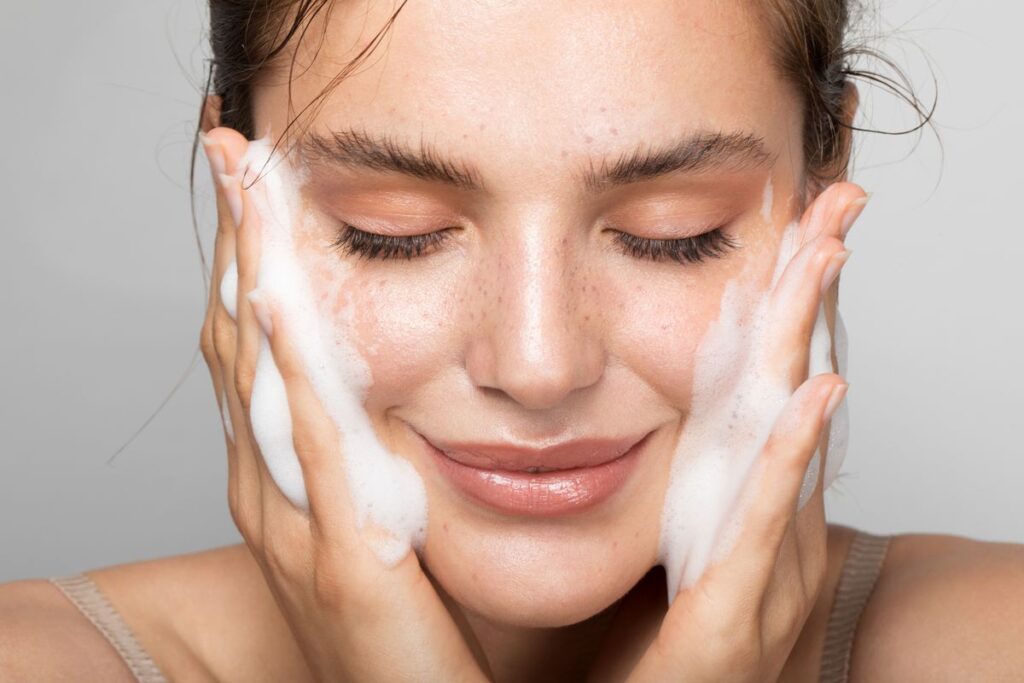A skincare routine helps in maintaining the health of your skin. Because everyday Your skin is exposed to various environmental factors like pollution, UV radiation, and harsh weather conditions.
A skincare routine with appropriate products can act as a protective barrier, shielding your skin from these external factors and minimising potential damage.
Regularly following a skincare routine can improve the texture and tone of your skin. Exfoliating helps remove dead skin cells, revealing a smoother complexion, while certain skincare ingredients can target skin discoloration, hyperpigmentation, or uneven skin tone, resulting in a more even and glowing complexion.
Remember that everyone’s skin is unique, so it’s important to develop a skincare routine that suits your skin type and concerns. Consulting with a dermatologist or skincare professional can provide personalised advice and recommendations for an effective routine.
For those new to skincare, starting with a simple routine is the key. You can follow these easy and simple 10-Step Skincare Routines.
The 10-step skincare routine, originated in South Korea is a perfect comprehensive approach to skincare routine for beginners.
It involves a series of steps to thoroughly cleanse, exfoliate, hydrate, and protect the skin. The routine typically includes:
- Oil-based cleanser to remove makeup and impurities.
- Water-based cleanser to cleanse the skin.
- Exfoliator to remove dead skin cells.
- Toner to balance the skin’s pH levels.
- Essence to hydrate and nourish.
- Serum or ampoule to address specific concerns.
- Sheet mask for an extra boost of hydration or treatment.
- Eye cream to moisturise and target the delicate eye area.
- Moisturiser to hydrate and seal in moisture.
- Lastly Sunscreen,as it is crucial for safeguarding the skin against harmful sun rays.
This multi-step routine allows for a thorough skin care experience. But
Concercing different skin types you can follow these step-by-step guides for morning and night skincare routines.
Morning Skincare Routine:
Normal Skin:
a) Cleanser: Start by washing your face with a gentle cleanser to remove any impurities from the skin. Massage it onto damp skin, then rinse thoroughly with lukewarm water.
b) Toner: Apply a toner to balance the skin’s pH levels and prep it for the following products. Pour a small amount onto a cotton pad and gently swipe it across your face.
c) Serum: Apply a hydrating serum to provide moisture and nourishment to your skin. Take a few drops of serum and gently press it into your skin using upward motions.
d) Eye Cream: Gently pat an eye cream around the delicate eye area to hydrate and reduce puffiness. Use your ring finger to apply a small amount of eye cream and gently tap it into the skin.
e) Moisturiser: Apply a lightweight moisturiser to keep your skin hydrated throughout the day. Take a pea-sized amount of moisturizer and massage it into your skin using upward strokes.
f) Sunscreen: Finish off with a broad-spectrum sunscreen with SPF 30 or higher to protect your skin from harmful UV rays. Apply an adequate amount to cover your face, neck, and other exposed areas.
Dry Skin:
The best skincare routine for dry skin aims to provide intense hydration and nourishment to combat dryness and flakiness. Follow the same steps as for normal skin, but consider using a richer, more emollient cleanser and moisturizer to provide extra hydration and nourishment to your skin. Look for products containing ingredients like hyaluronic acid and ceramides to lock in moisture.
Especially during winter, the skin tends to become drier and more prone to dehydration. It’s crucial to focus on deep hydration and protection. For the Winter skincare routine switch to a creamy and hydrating cleanser that doesn’t strip away essential oils.
Oily/Combination Skin:
The best skincare routine for oily skin focuses on oil control and maintaining a balanced complexion.
a) Cleanser: Start with a gentle, oil-free cleanser to remove excess sebum and impurities.
b) Toner: Apply a toner with ingredients like salicylic acid to help control oil production and minimize pores. Pour a small amount onto a cotton pad and gently swipe it across your face, focusing on oily areas.
c) Lightweight Moisturizer: Apply a lightweight, oil-free moisturizer to provide hydration without adding excess oil. Take a pea-sized amount and massage it into your skin using upward strokes.
d) Sunscreen: Finish off with a non-comedogenic sunscreen gel or lotion to protect your skin from the sun. Apply an adequate amount to cover your face, neck, and other exposed areas.
As far as oily skin is concerned, you should keep in mind that summer calls for adjustments in your skincare routine to combat the effects of heat, humidity, and increased sun exposure. Opt for lightweight and oil-free products that won’t clog pores or feel heavy on the skin for summer skincare routine.
Night Skincare Routine:
Normal Skin:
a) Makeup Remover/Cleansing Oil: Begin by removing makeup and dirt with a gentle makeup remover or cleansing oil. Massage it onto dry skin, focusing on areas with makeup, then rinse thoroughly with lukewarm water.
b) Cleanser: Follow up with a gentle cleanser to ensure your skin is thoroughly clean. Massage it onto damp skin, then rinse thoroughly with lukewarm water.
c) Toner: Apply a hydrating toner to balance your skin’s pH levels and prepare it for the next products. Pour a small amount onto a cotton pad and gently swipe it across your face.
d) Treatment (Optional): If you have specific concerns like acne or hyperpigmentation, apply a targeted treatment product. Follow the instructions provided with the product for application.
e) Night Cream/Serum: Apply a nourishing night cream or serum to provide intense hydration and repair your skin while you sleep. Take a small amount and gently press it into your skin using upward motions.
f) Eye Cream: Gently pat an eye cream around the delicate eye area to hydrate and target any specific concerns. Use your ring finger to apply a small amount of eye cream and gently tap it into the skin.
g) Lip Balm: Apply a nourishing lip balm to keep your lips moisturised. Choose a lip balm with hydrating ingredients like shea butter or coconut oil and apply it generously to your lips.
Dry Skin:
Follow the same steps as for normal skin, but consider using a creamy cleanser, a richer night cream or facial oil, and a lip balm with extra hydration for dry lips. For a night skincare routine for dry skin, look for products containing ingredients like hyaluronic acid, glycerin, or oils such as argan or rosehip oil to deeply moisturise and nourish your skin.
Oily/Combination Skin:
a) Makeup Remover/Cleansing Oil: Start by removing makeup and dirt with a gentle makeup remover or cleansing oil.
b) Cleanser: Use a gel or foaming cleanser to thoroughly cleanse your skin and remove excess oil.
c) Toner: Apply a toner with exfoliating properties to help control oil and refine pores. Pour a small amount onto a cotton pad and gently swipe it across your face, focusing on oily areas.
d) Treatment (Optional): If you have specific concerns like acne or congestion, apply a targeted treatment product. Look for ingredients like salicylic acid or tea tree oil to address these concerns. Follow the instructions provided with the product for application.
e) Lightweight Night Moisturizer/Gel: Apply a lightweight night moisturizer or gel to provide hydration without clogging pores. Take a pea-sized amount and massage it into your skin using upward strokes.
f) Eye Cream: Gently pat an eye cream around the delicate eye area to hydrate and address any specific concerns. Use your ring finger to apply a small amount of eye cream and gently tap it into the skin.
g) Lip Balm: Apply a light, non-greasy lip balm to keep your lips moisturized without adding excess oil. Look for oil-free options that provide hydration without clogging the pores around your lips.
Remember to adjust your skincare routine based on your individual skin type and concerns as well as keep in mind that skincare routine order is crucial to ensure that each product can work effectively.
If you have Acne-Prone Skin then the best skincare routine for acne-prone skin should focus on gentle cleansing, exfoliation, and targeted treatments to address breakouts and minimise inflammation.
The best skincare routine for combination skin should aim to balance oiliness in the T-zone while providing hydration to dry areas. It’s important to adjust products and treatments based on specific areas of the face to cater to both oily and dry skin needs.
The best skincare routine for sensitive skin focuses on gentle, soothing, and non-irritating products to minimise potential reactions and flare-ups.
The best skincare routine for ageing skin aims to hydrate, nourish, and target common signs of ageing like fine lines.
You can also follow organic skincare routines or DIY skin routines.
An organic skincare routine focuses on using products made with natural and organic ingredients, free from synthetic chemicals and artificial additives. And a DIY skincare routine involves creating homemade skincare products using natural ingredients found in your kitchen or local stores. DIY skincare routines can be a fun and affordable Skincare Routine.
Just in case you are travelling, maintaining a travel skincare routine can be challenging, but it’s important to care for your skin even on the go. You can learn from different DIY skincare routines about how to Opt for travel-sized versions of your favourite products or decant them into travel-friendly containers.
Check out the website of biossance at tipsaving if you are looking forward to following the Clean Beauty Routine. Biossance products made with non-toxic and natural ingredients help you avoid harmful chemicals, so that you can have a non-toxic skincare routine. You can use Biossance promo codes to get discounts on their highly effective products.
However, For those seeking a more indulgent skincare experience, a luxury skincare routine can provide a touch of opulence and high-quality ingredients.
Skincare Routine Mistakes to Avoid:
When it comes to skincare, it’s important to be aware of common mistakes to ensure you’re not compromising the health and appearance of your skin.
One common mistake is over-exfoliating, which can lead to dryness, sensitivity, and irritation. Stick to exfoliating once or twice a week, depending on your skin type. Another mistake is not wearing sunscreen daily. UV rays can damage the skin and accelerate ageing, so incorporate a broad-spectrum sunscreen into your routine, even on cloudy days.
Additionally, avoid using too many products at once, as this can overwhelm the skin and disrupt its balance. Be cautious with hot water when cleansing, as it can strip the skin of its natural oils. Stick to lukewarm water to avoid drying out your skin.




